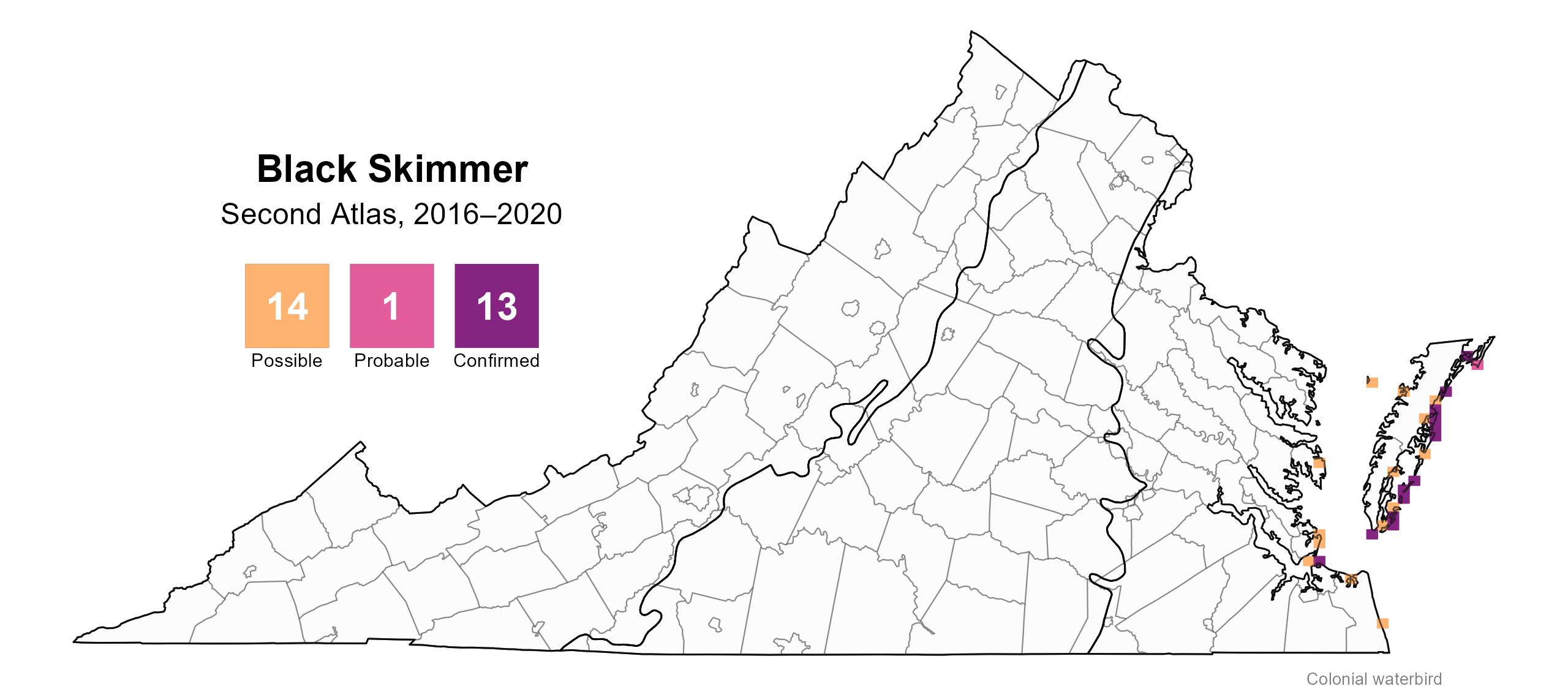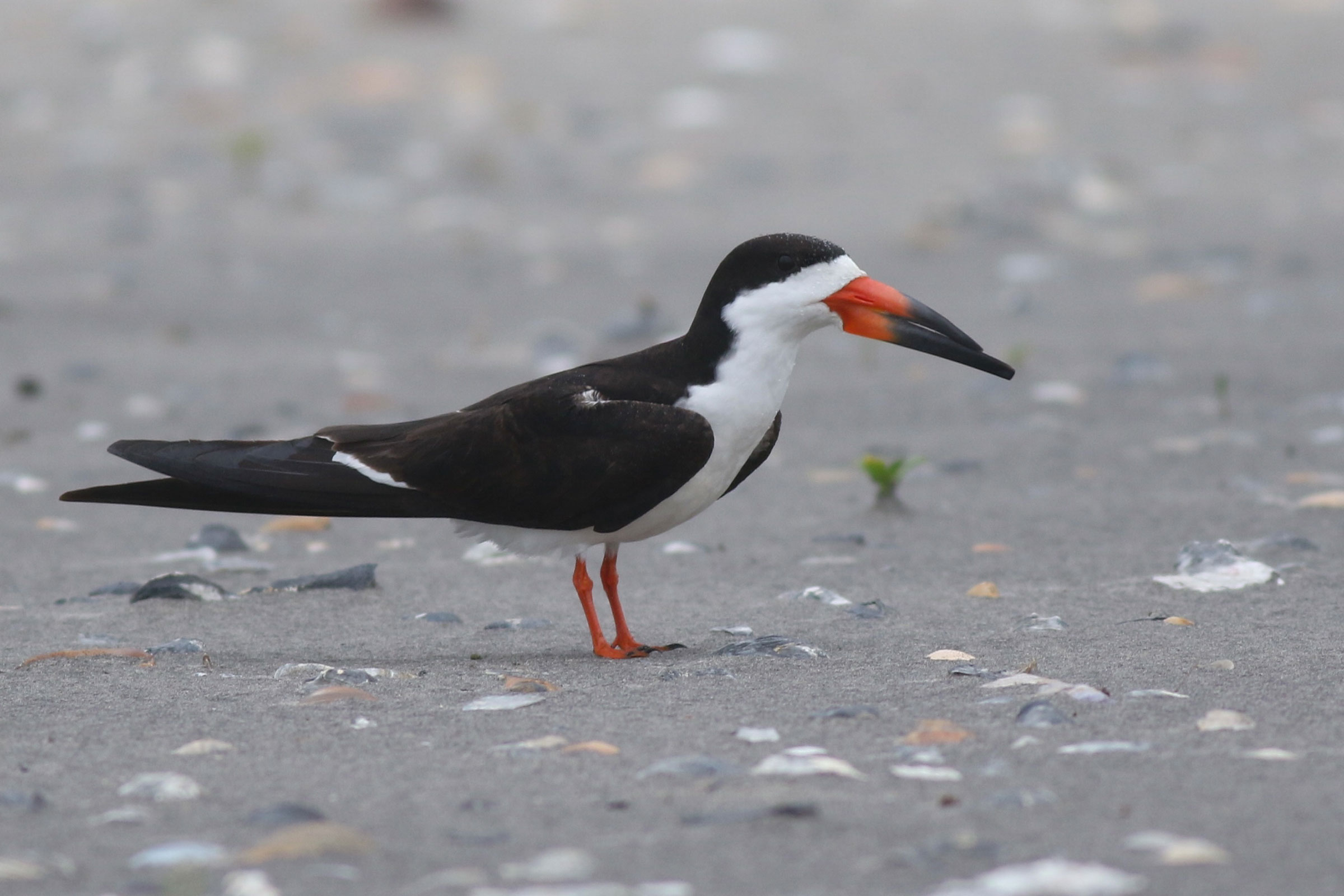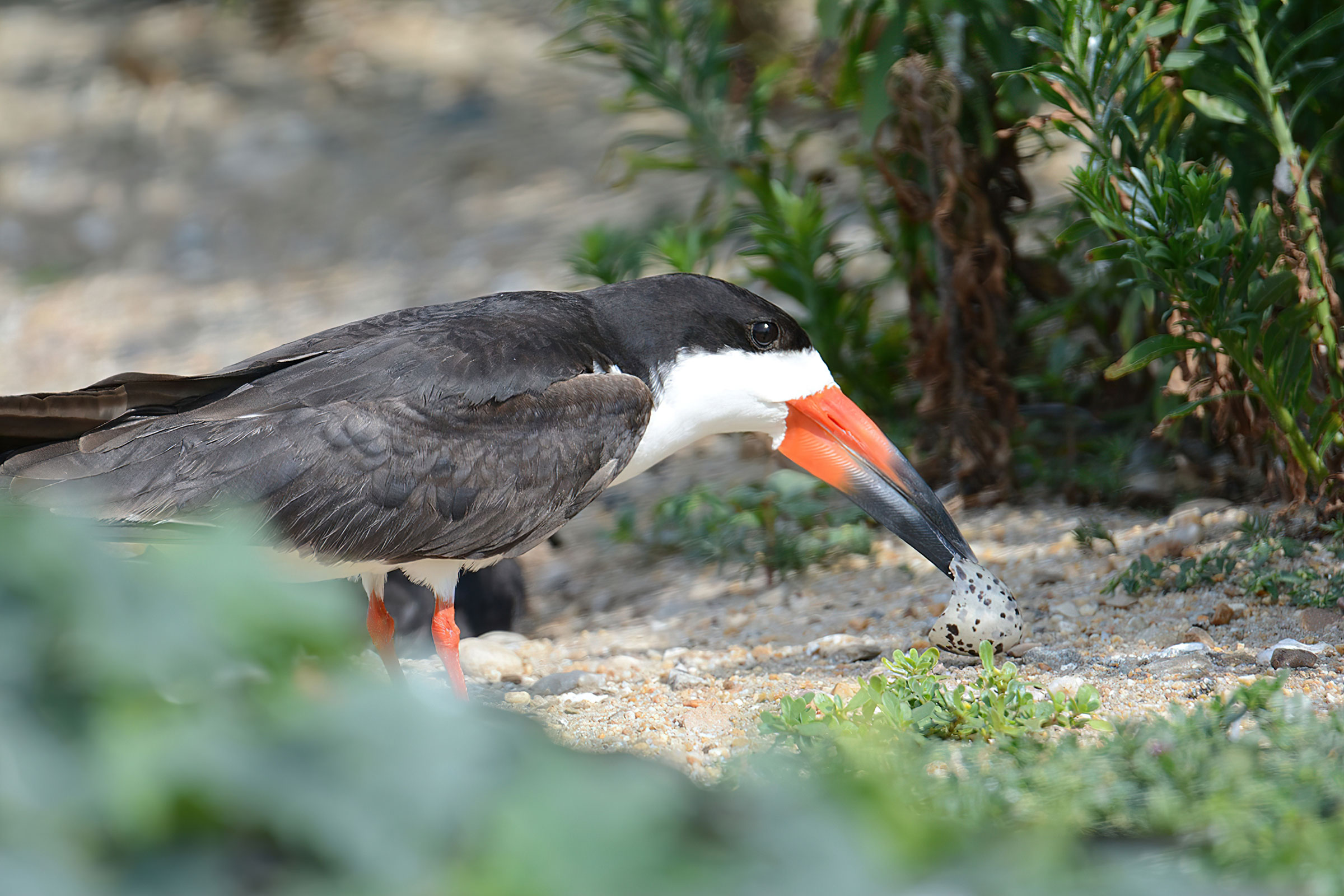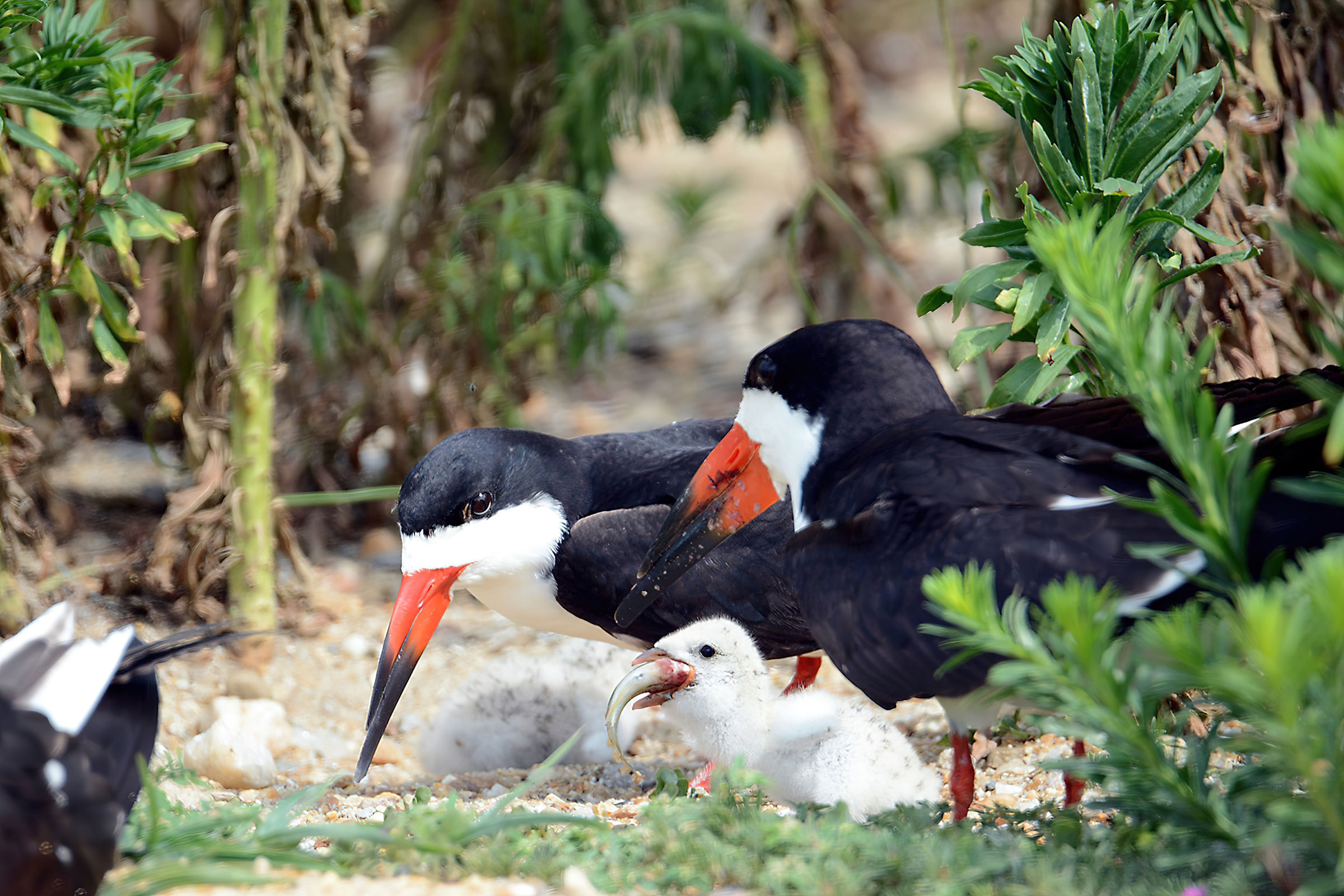Introduction
The Black Skimmer is a distinctive, lantern-jawed bird named for the way its long lower bill skims the water’s surface to capture prey. Historically known as the “sea dog” in Virginia due to its barking call (Howell 1911), this colonial nesting species often associates with terns, relying on them for alerting and defending against predators (Gochfeld et al. 2020). While typically nesting on beaches, Black Skimmers also use man-made structures (Watts et al. 2019). They are commonly found in the lower Chesapeake Bay and are rarely recorded elsewhere in Virginia. Despite being the focus of a recent major conservation success story (see Conservation section), they remain under threat due to habitat loss and human disturbance.
Breeding Distribution
The Black Skimmer was well-covered during the Second Atlas by the 2018 Virginia Colonial Waterbird Survey, a coastal census conducted by the Center for Conservation Biology in collaboration with the Virginia Department of Wildlife Resources (VDWR) and The Nature Conservancy. The survey identifies nesting locations of this and other species that breed in colonies. Because the Black Skimmer only breeds within the survey area, there was no need to model its distribution. For information on where the species occurs in Virginia’s Coastal Plain, please see the Breeding Evidence section.
Breeding Evidence
Black Skimmers nest exclusively within the survey area covered by the Virginia Colonial Waterbird Survey in 2018, and this survey documented the locations of breeding colonies of this species. Therefore, the species is unlikely to have nested in blocks without confirmed breeding evidence. Additional breeding confirmations were reported by Atlas volunteers in other years of the Second Atlas period.
Black Skimmers were confirmed breeders in 13 blocks in two counties and two cities (Figure 1). On the mainland, they were confirmed on the Hampton Roads Bridge-Tunnel (HRBT) in Hampton and Norfolk. On the Eastern Shore, they bred on many of the barrier islands, including Smith Island, Wrack Island, and Cobb Island in Northampton County and Cedar Island, Metompkin Island, and the Chincoteague Island Causeway in Accomack County. The two largest populations surveyed in 2018 were at the HRBT and on Cedar Island (Watts et al. 2019). During the First Atlas, the species was confirmed in 18 blocks, all but two of which were on the Eastern Shore (Figure 2).
The earliest confirmed breeding behavior was of Black Skimmers on the nest starting May 20, and the earliest eggs were observed June 8 (Figure 3). Fledglings were seen from June 15 to August 27. For more general information on the breeding habits of the Black Skimmer, please refer to All About Birds.

Figure 1: Black Skimmer breeding observations from the Second Atlas (2016–2020). The colored boxes illustrate Atlas blocks (approximately 10 mi2 [26 km2] survey units) where the species was detected. The colors show the highest breeding category recorded in a block. The numbers within the colors in the legend correspond to the number of blocks with that breeding evidence category. Nesting is unlikely outside of confirmed blocks.

Figure 2: Black Skimmer breeding observations from the First Atlas (1985–1989). The colored boxes illustrate Atlas blocks (approximately 10 mi2 [26 km2] survey units) where the species was detected. The colors show the highest breeding category recorded in a block. The numbers within the colors in the legend correspond to the number of blocks with that breeding evidence category.

Figure 3: Black Skimmer phenology: confirmed breeding codes. This graph shows a timeline of confirmed breeding behaviors. Tick marks represent individual observations of the behavior.
Population Status
Black Skimmers had too few detections during the Atlas point count surveys to develop an abundance model. However, the distribution and size of Black Skimmer colonies derived from the 2018 Virginia Colonial Waterbird Survey are displayed on the CCB Mapping Portal.
The Virginia Colonial Waterbird Surveys show that the number of Black Skimmer breeding pairs declined from 2,459 pairs to 965 pairs from 1993 to 2018, a decline of 49.4% (Watts et al. 2019; Figure 4). However, by 2023, its population had increased, reaching 1480 pairs (Watts et al. 2024). Overall, since 2013, declines have tapered off, and the population has stabilized, due in part to strong colonies on Smith Island, Cedar Sandbar, and the HRBT (Watts et al. 2024).

Figure 4: Black Skimmer population trend for Virginia’s Coastal Plain. This chart illustrates the number of breeding pairs as estimated by the Virginia Colonial Waterbird Survey (Watts et al. 2024). The vertical light blue bars represent the periods corresponding to the First Atlas (1985–1989) and Second Atlas (2016–2020).
Conservation
As colonial-nesting species, Black Skimmers are vulnerable to disturbance and loss of nesting sites. Shore habitat can be lost to rising sea levels or human activity. Given its level of vulnerability, the 2025 Virginia Wildlife Action Plan includes this species as a Tier III Species of Greatest Conservation Need (High Conservation Need), indicating the need for management actions to stabilize or increase the population (VDWR 2025). Various activities involving this species have occurred within the state. For example, one of the strongest colonies in Virginia was recently displaced when the Virginia Department of Transportation began a project to expand the HRBT. In 2020, the South Island HRBT expansion project paved over the former nesting site. The VDWR and partners were able to provide alternative habitat on the historic Fort Wool (also known as Rip Raps Island) and floating barges, which now provide replacement habitat for multiple nesting seabird species, including Black Skimmers. A survey in 2024 showed Black Skimmers nesting on two of the three barges used as alternative habitat (Sweeney et al. 2024). As with many other beach-nesting species, Black Skimmers can be protected by restricting disturbance and promoting public awareness around their nesting sites.
Interactive Map
The interactive map contains up to six Atlas layers (probability of occurrence for the First and Second Atlases, change in probability of occurrence between Atlases, breeding evidence for the First and Second Atlases, and abundance for the Second Atlas) that can be viewed one at a time. To view an Atlas map layer, mouse over the layer box in the upper left. County lines and physiographic regional boundaries (Mountains and Valleys, Piedmont, and Coastal Plain) can be turned on and off by checking or unchecking the box below the layer box. Within the map window, users can hover on a block to see its value for each layer and pan and zoom to see roads, towns, and other features of interest that are visible beneath a selected layer.
View Interactive Map in Full Screen
References
Gochfeld, M., J. Burger, and K. L. Lefevre (2020). Black Skimmer (Rhynchops Niger), Version 1.0. In Birds of the World (S. M. Billerman, Editor). Cornell Lab of Ornithology, Ithaca, NY, USA. https://doi.org/10.2173/bow.blkski.01.
Howell, A. B. (1911). A comparative study at Cobb’s Island, VA. The Auk 28: 449–453.
Rottenborn, S. C., and E. S. Brinkley (Editors) (2007). Virginia’s birdlife: an annotated checklist. 4th edition. Virginia Society of Ornithology.
Sweeney, C., K. Hunt, J. Fraser, and S. Karpanty (2024). Assessing avian response to the relocation of Virginia’s largest seabird colony, 2024 annual report. Virginia Polytechnic Institute and State University, Blacksburg, VA, USA.
Virginia Department of Wildlife Resources (VDWR) (2025). Virginia wildlife action plan. Virginia Department of Wildlife Resources, Henrico, VA, USA. 506 pp.
Watts, B. D., B. J. Paxton, R. B., and A. L Wilke (2019). Status and distribution of colonial waterbirds in coastal Virginia: 2018 breeding season. CCBTR-19-06. College of William and Mary and Virginia Commonwealth University. Williamsburg, VA, USA.
Watts, B. D., B. J. Paxton, R. B., and A. L Wilke (2024). Status and distribution of colonial waterbirds in coastal Virginia: 2023 breeding season. CCBTR-24-12. College of William and Mary and Virginia Commonwealth University. Williamsburg, VA, USA.






